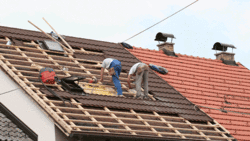Fall Protection - Residential Construction
/May 2017
By Bill Christenson
 Falls are the most common type of injury accident on construction projects. We typically see temporary guardrails installed at heights or workers wearing fall protection harnesses with lanyards on commercial projects, but how about residential construction? It’s not uncommon to see workers on residential construction and single family home projects working unprotected around fall hazards, so are safety regulations less stringent for residential versus commercial construction? No! Fall protection pertaining to any construction work is mandated by Washington Administrative Code (WAC) 296-155, Part C-1.
Falls are the most common type of injury accident on construction projects. We typically see temporary guardrails installed at heights or workers wearing fall protection harnesses with lanyards on commercial projects, but how about residential construction? It’s not uncommon to see workers on residential construction and single family home projects working unprotected around fall hazards, so are safety regulations less stringent for residential versus commercial construction? No! Fall protection pertaining to any construction work is mandated by Washington Administrative Code (WAC) 296-155, Part C-1.
Fall protection requirements are not just for hazards above 10 feet high. Floor holes and floor openings regardless of height must be guarded. Fall protection is required at the height of 4 feet or more at open-sided walking/working surfaces as well as ramps. Work activity on high slope roofs (4:12 pitch or greater) where a fall hazard of 4 feet or more exists also requires fall protection. Where employees are exposed to fall hazards of 10 feet or more, fall protection is required, as well as a written fall protection work plan.
The compliant means of fall protection are addressed in WAC 296-155, Part C-1 and include:
Fall arrest systems – Stopped after the fall with a 6 foot maximum free fall distance
- Personal fall arrest with full body harness and lanyards
- Safety nets
- Catch platforms
Fall restraint systems – Restrained from falling
- Guardrails
- Covers
- Warning line system
- Personal fall restraint
Positioning device system
- Positioning harness/full body harness with a 2 foot maximum free fall distance
Other common construction activities that require fall protection include:
- Working on elevating platforms and aerial platforms (Reference WAC 296-869)
- Working on scaffolds (Reference WAC 296-874)
- Working on ladders (Reference WAC 296-876)
In addition to having the proper means and methods for fall protection, all personnel are required to be trained in the proper use of the fall protection. According to WAC 296-155-24621, all training must be documented and documentation kept on file.
Contractors and workers need to know their responsibilities and ensure that proper fall protection is used at all fall hazard conditions.